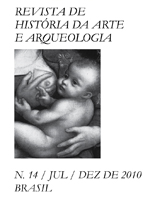Abstract
This article intends to emphasize the importance of the semiotic method for the archaeological studies in general. In order to show the relevance of this methodology, we present a case study based on the analysis of a Mochica artifact, which serves as basis for a complex iconography, closely related to the principles that form the basis of the andean cosmology.
References
ALVA, W. Tesouros do Senhor de Sipán, Peru – O Esplendor da Cultura Mochica. São Paulo: Stilgraf, 2006; p. 111-125.
ARCURI, M. et al. Por Ti América: Arte Pré-Colombiana. Rio de Janeiro: Pancron, 2005, p.56
BARTHES, Roland. Système de la Mode. Paris: Seuil, 1957.
RENFREW, C.; BAHN, P. Archaeology – Theories, Methods and Practice. London: Thames & Hudson Ltd., 1991, p. 391.
BAWDEN, G. “Moche Culture as Political Ideology”. Latin American Antiquity, v. 6, n. 3, 1995, p. 255-273; p. 258.
CASTILLO B. L. J. “La Cerimônia del Sacrifício – Batalla y Muerte el Arte Mochica”. Catalogue of the exposition. Museu Arqueológico Rafael Larco Herrera, Feb to Aug 2000. Lima, 2000.
FLANNERY, K. V.; MARCUS, J. “Cognitive Archaeology”. In: WHITLEY, D. S. (Ed.) Reader in Archaeological Theory. Post-Processual and Cognitive Approaches. London: Routledge, 1998, p. 35-38.
LARCO HOYLE, R. (1938). Los Mochicas. Tomo I. Lima: Metrocolor, 2001,p. 318.
GE RVEREAU, Laurent. Ver, Compreender, Analisar as Imagens. Lisboa: Edições 70, 2004, p. 10.
ROSTWOROWSKI, M. D. C. Estructuras Andinas del Poder – Ideología Religiosa y política. Lima: Instituto de Estudios Peruanos, IEP, 1998, p. 15

This work is licensed under a Creative Commons Attribution 4.0 International License.
Copyright (c) 2021 Journal of Art History and Culture

